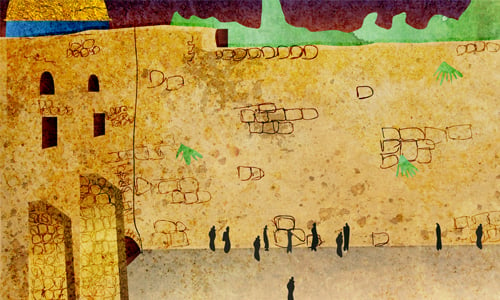Question:
The Western Wall is one of the four walls that supported the Temple Mount. Why is it considered more special than the other three, all of which are clearly visible?
Reply:
Believe it or not, the Western Wall (sometimes called the Wailing Wall1 or Kotel), is actually the only surviving wall of the Temple Mount. Much of the structure we see today was rebuilt during the 2,000 years since the Temple was destroyed.
There are almost no ancient remains of the northern wall. There is a bit of the eastern wall, as well as almost the entire southern wall. However, none of those walls actually bordered the holy ground of the Temple. The actual southern wall was further north than the existing southern wall, which was built by Herod and enclosed an annexed area next to the sacred ground of the Temple. So the Western Wall is the only hallowed wall that remains.2
How did the Western Wall survive? The Midrash tells a fascinating tale:
When Vespasian conquered Jerusalem, he assigned the destruction of the four ramparts3 of the Temple to four generals. The western wall was allotted to Pangar of Arabia. Now, it had been decreed by Heaven that this should never be destroyed, because the Shechinah (Divine Presence) resides in the west.
The others demolished their sections, but Pangar did not demolish his. Vespasian sent for him and asked, “Why did you not destroy your section?” He replied, “By your life, I acted so for the honor of the kingdom. For if I had demolished it, nobody would [in time to come] know what it was you destroyed. But when people look [at the surviving wall], they will exclaim, ‘From the great building he destroyed, you can tell the might of Vespasian!’”
Vespasian said to him, “Enough! You have spoken well. But since you disobeyed my command, you shall ascend to the roof and throw yourself down. If you live, you will live, and if you die, you will die.”’ Pangar ascended, threw himself down and died.4
What It Means
We read in Song of Songs, “Behold, He is standing behind our wall, looking from the windows, peering from the lattices.”5 The Midrash explains that this refers to the Western Wall. “Why is this so? Because the Holy One, Blessed be He, has taken an oath that it will never be destroyed.”6
Based on this verse, the Zohar states: “The Divine Presence never departed from the Western Wall of the Temple.”7 This is seen as a manifestation of G‑d’s promise to Solomon when the Temple was first built, that “My eyes and heart will be there at all times.”8
The Zohar explains that this idea is hinted to in the word kotel (כותל), which can be broken into two words, כו תל. The word כו is the numeric value of 26, the value of the Tetragrammaton. And the word תל means “hill” or “mountain.” Thus, the Kotel’s very name hints to the fact that G‑d’s Divine Presence is still to be found on the Temple Mount.9
Western Wall of What?
Some people have suggested that the current Western Wall is a part of the Temple itself.10 However, most maintain that the Western Wall is actually a part of the retaining wall that surrounded the Temple Mount.11 Indeed, if one examines the dimensions of the Wall, this seems to be borne out.12
Interestingly, if the Western Wall is actually a supporting wall for the Temple Mount, it would explain a teaching found in Midrash Tehillim that states that “although [the Temple Mount] is [now] a bare mountain, it remains in its sanctity” and then goes on to say that “the Divine Presence never left the Western Wall.” Why is the Temple Mount referred to as a “bare mountain” if the Western Wall was never destroyed? Because the Wall is not on the mountain, but a retaining wall of the mountain.13
Wall to Holiness
Although the intention of the enemies of Israel in leaving the wall intact was to show the glory of Rome and the subjection of the Jewish nation, the opposite transpired. Rome is long buried in the dustbin of history, but the Western Wall has remained as a beacon of hope, signifying G‑d’s eternal promise that His children will ultimately return to the land and that the Temple will be rebuilt.







Join the Discussion